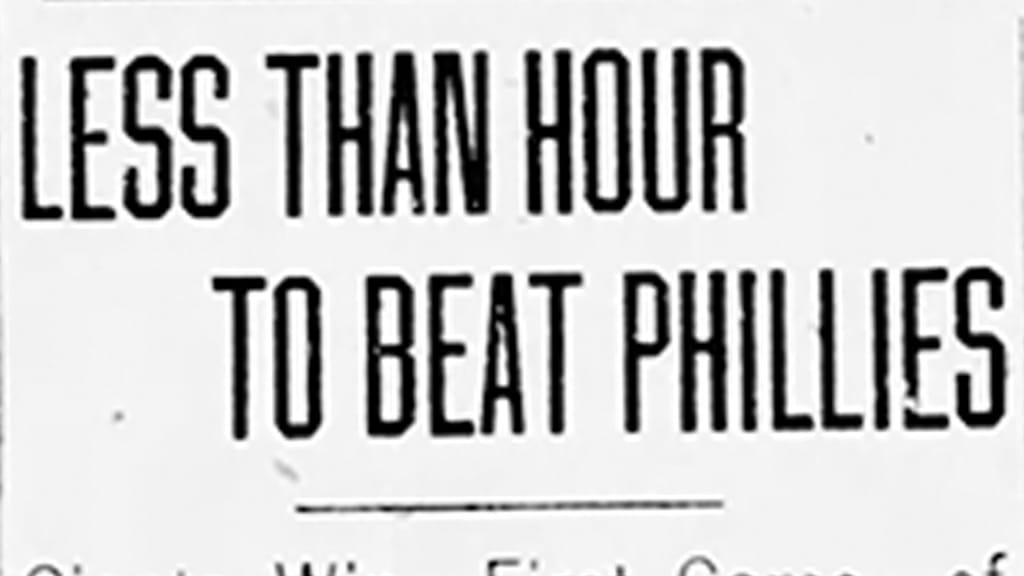
"LESS THAN HOUR TO BEAT THE PHILLIES."
That was the one-column headline in the Sept. 29, 1919, Philadelphia Inquirer. The day before, the Phillies closed out the season with 6-1 and 7-1 losses in a season-ending doubleheader against the New York Giants at the Polo Grounds.
While Major League Baseball games were the fastest (2:39) in 2023 since 1984 (2:35), the first game that Sunday afternoon at the Giants remains the all-time record.
“In losing the early struggle, however, the Phillies established a new record for playing a nine-inning game in the shortest space of time. It required only fifty-one minutes to complete the game,” was the second paragraph of a three-graf story in the Inquirer.
No details were given as to the reason for the quick game. No record is available for the second game time, which was the last game of the season.
I found a story written by Dave Caldwell in The Guardian on July 4, 2023, about the ultra-fast game. Excerpts from that story:
“So, players had incentive for wrapping it up quickly so they could head back to the hinterlands for the winter. Moreover, the final scheduled games of the season, to be played on 29 and 30 September, were moved up so the Giants could stage a Sunday doubleheader at the Polo Grounds. Two games for the price of one always draws fans.”
Attendance listed as 14,000.
“Accomplishing something in record time was in fashion back in those days. According to the new Illustrated Daily News (later the New York Daily News), the record for a big league nine-inning game had been 56 minutes, set by the Giants and Brooklyn on 30 August 1918.
“Both Giants and Phils agreed to go after the speed record before the game started,” the Daily News reported. “That they shattered the mark and still scored seven runs is remarkable. The men went up intent on smacking the first pitch. They did for the most part, and this led to the hasty finish.”
“The New York Times, careful as ever, labeled the game as ‘certainly the fastest game played in the Major Leagues in many years, and probably a record.’ The same two teams had played nine innings in 32 minutes in 1913, but that was an exhibition (in more ways than one).
“Further, the Times reported that in the 51-minute game that ‘there was no unusual effort to make a speed record until the Phils’ half of the ninth. At that time, it became apparent to the players that they could do something unusual, and for a half-inning, they hustled.’”
“The Giants’ starting pitcher was Jesse Barnes, seeking his 25th victory of the season. Barnes was even better than usual in a complete-game effort that day, allowing five hits and one unearned run, which the Phillies scored with two outs in the top of the first.
“Probably owing to the fact that the Phillies were so eager to swing, he did not walk a batter and struck out only two -- ‘nor did he hit anybody,’ the Sun reported. He retired 17 straight batters between the first and seventh innings. The New York American reported he threw only 64 pitches, setting a big league record.
“The Phillies were entirely baffled by his twisters,” the Sun reported. “They got only two hits up to the seventh inning. For the first five innings, the New York outfielders did not have a putout, and they accumulated only two after that.
“The Giants fared much better against Philadelphia pitcher Lee ‘Specs’ Meadows, who failed to avoid his 20th loss of the season. Meadows gave up 13 hits and six runs, all earned, but he walked just three hitters and lasted all nine innings, helping to move things along. It also helped that the Giants scored all six of their runs in the first six innings.”
The 24-year-old Meadows began that season with the St. Louis Cardinals (4-10) before being traded to the Phillies on July 14. He was 8-10 for the Phils.
Why was the right-hander nicknamed “Specs”? He wore glasses in his first Major League start (1915), the first player in the modern era to wear specs.